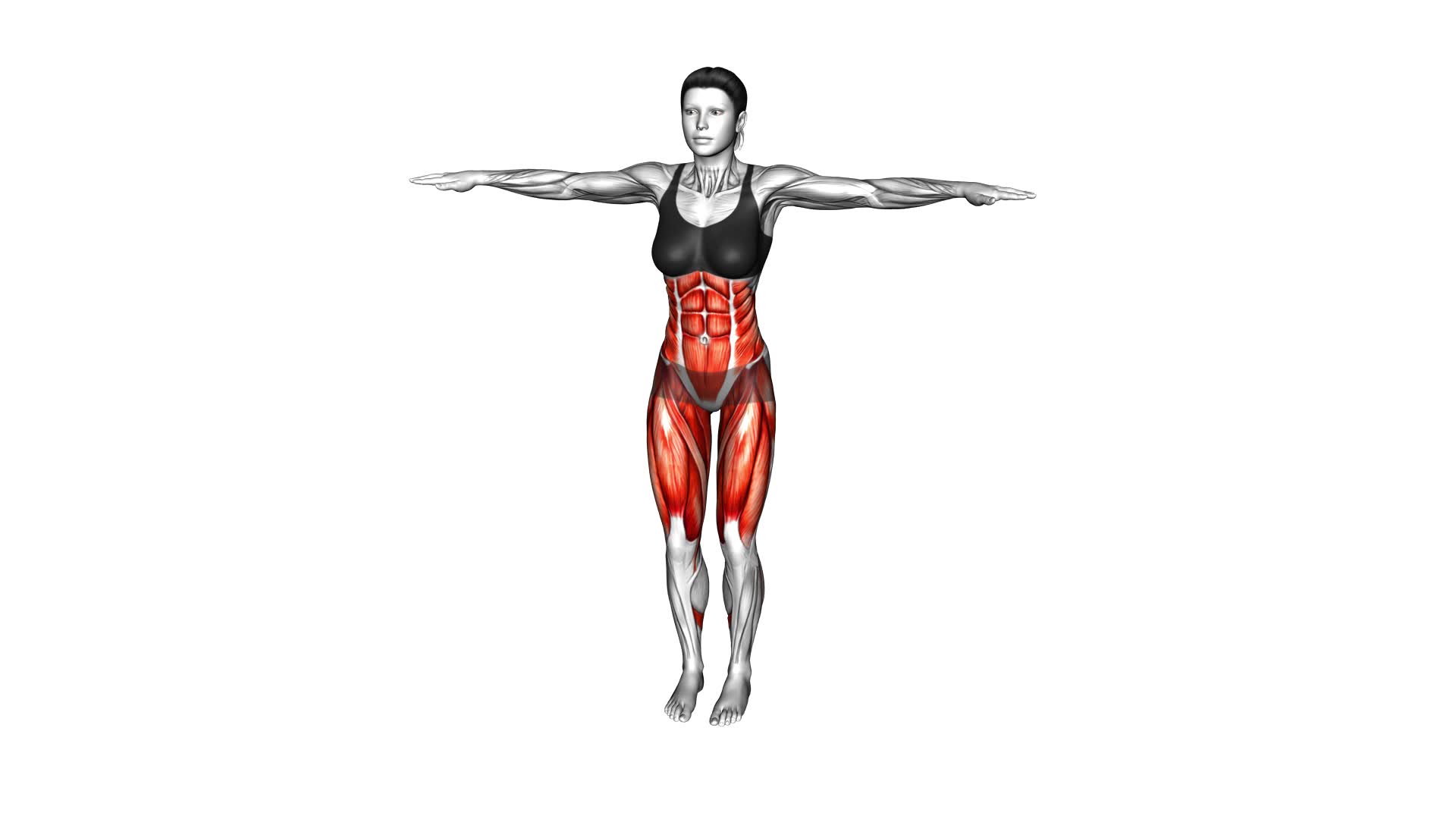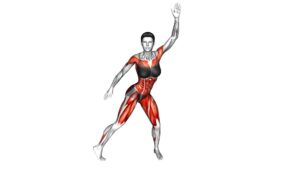Diagonal Lunge (female) – Video Exercise Guide & Tips

Are you looking for a new exercise to add to your routine? Look no further than the diagonal lunge! This video exercise guide and tips article will show you how to properly perform the diagonal lunge, as well as the benefits it can bring to your fitness journey.
Watch This Exercise Video
Don't make common mistakes – learn the correct form and technique, and discover variations and progressions to challenge yourself.
Get ready to incorporate the diagonal lunge into your workout routine and maximize your results!
Key Takeaways
- The diagonal lunge targets multiple muscle groups including quadriceps, glutes, hamstrings, and calf muscles.
- Proper form and technique, such as maintaining alignment and avoiding leaning forward or rounding the back, are important to maximize benefits and minimize the risk of injury.
- Proper alignment during the diagonal lunge is crucial as it maximizes benefits, prevents strain on other areas of the body, and contributes to balance and stability.
- Common mistakes to avoid during the diagonal lunge include lunging too far forward, failing to engage core muscles, and leaning too far forward or rounding the shoulders. Focusing on keeping the chest lifted, shoulders back, and core activated can help reduce the risk of injury.
Benefits of the Diagonal Lunge
The diagonal lunge provides a range of benefits for your lower body muscles. Not only does it target your quadriceps and glutes, but it also engages your hamstrings and calf muscles. By performing this exercise, you can improve your overall lower body strength and tone.
One of the key benefits of the diagonal lunge is its ability to improve balance. As you step forward and rotate your torso, you challenge your body's stability and coordination. This helps to strengthen the muscles that are responsible for maintaining your balance, such as your core and hip stabilizers.
Speaking of the core, the diagonal lunge is also an excellent exercise for strengthening this important muscle group. As you lunge diagonally, you engage your abdominal muscles to stabilize your spine and maintain proper posture. This not only helps to improve your balance but also enhances your overall functional strength.
In addition to the physical benefits, the diagonal lunge can also have a positive impact on your athletic performance. By targeting multiple muscle groups simultaneously, this exercise mimics the movements and demands of many sports and activities. Incorporating the diagonal lunge into your workout routine can help you become stronger, more agile, and more efficient in your movements.
Proper Form and Technique
To perform the diagonal lunge with proper form and technique, it's crucial to focus on alignment. Keep your chest up and shoulders back, ensuring that your knee doesn't extend beyond your toes.
Avoid common mistakes such as leaning forward or rounding your back, as these can put unnecessary strain on your joints. By maintaining proper form, you can maximize the benefits of the diagonal lunge and minimize the risk of injury.
Importance of Alignment
Ensure proper alignment in your diagonal lunges to maximize the benefits and prevent injury. Alignment plays a crucial role in the effectiveness of your exercise and the overall safety of your body.
When performing diagonal lunges, it's essential to maintain proper form and technique to ensure that your body is in the correct position. This not only helps in engaging the targeted muscles but also prevents strain on other areas of your body. Proper alignment also contributes to the role of balance, allowing you to maintain stability and control throughout the movement.
Common Mistakes to Avoid
Maintain proper form and technique to avoid common mistakes in your diagonal lunges, allowing for optimal alignment and maximizing the benefits of the exercise.
One of the most common mistakes people make is lunging too far forward, which can strain the knee joint and lead to injury. Another common error is failing to engage the core muscles, which reduces stability and limits the effectiveness of the exercise.
Additionally, leaning too far forward or rounding the shoulders can compromise your form and put unnecessary stress on the lower back. To prevent these mistakes, focus on keeping your chest lifted, shoulders back, and core activated throughout the movement.
By avoiding these common errors, you can ensure that you're getting the most out of your diagonal lunges and reducing the risk of injury.
Now, let's explore the benefits of maintaining proper form.
Benefits of Proper Form
By maintaining proper form and technique in your diagonal lunges, you can experience a range of benefits for your overall fitness and muscle development. One of the main advantages of proper form is maximizing the effectiveness of the exercise. When you perform diagonal lunges correctly, you engage multiple muscle groups, including your quadriceps, glutes, hamstrings, and core. This leads to improved strength, stability, and balance.
Additionally, proper form helps prevent injuries by reducing stress on your joints and ensuring that the muscles are working in the intended way. It's important to note that there are common misconceptions about the proper form for diagonal lunges, such as not stepping far enough or not maintaining a straight back.
Common Mistakes to Avoid
To avoid common mistakes, make sure you keep your knees aligned and maintain proper form throughout the diagonal lunge exercise.
One common mistake is allowing your knees to collapse inward as you lunge. This can put unnecessary stress on your knee joints and increase the risk of injury. To improve, focus on keeping your knees in line with your toes throughout the entire movement.
Another mistake to watch out for is leaning too far forward or backward. This can throw off your balance and compromise the effectiveness of the exercise. Instead, keep your torso upright, engage your core, and maintain a neutral spine.
Lastly, avoid rushing through the exercise and sacrificing form for speed. Take your time and perform each lunge with control and precision.
By avoiding these common mistakes and focusing on proper form, you can maximize the benefits of the diagonal lunge exercise.
Now, let's move on to the variations and progressions to continue challenging yourself and further improve your fitness level.
Variations and Progressions
To continue challenging yourself and further improve your fitness level, you can explore different variations and progressions of the diagonal lunge exercise. These advanced modifications won't only increase the difficulty of the exercise but also target different muscle groups, resulting in enhanced muscle activation.
One variation you can try is the weighted diagonal lunge. Hold a dumbbell or kettlebell in each hand while performing the lunge to add resistance and increase the intensity. This will engage your upper body and core muscles, providing a full-body workout.
Another progression is the jumping diagonal lunge. Instead of stepping back into the lunge, explosively jump and switch legs in mid-air. This plyometric movement will challenge your cardiovascular endurance and explosiveness.
For a more challenging variation, you can incorporate a twist into the lunge. As you lower into the lunge position, rotate your torso towards the front leg. This will engage your obliques and improve rotational stability.
Incorporating the Diagonal Lunge Into Your Workout Routine
Once you have mastered the variations and progressions of the diagonal lunge, it's time to incorporate this exercise into your workout routine.
The diagonal lunge is a fantastic exercise for targeting your glutes, quads, and hamstrings, and by including it in your routine, you can maximize your results and take your fitness to the next level.
To start, you can add the diagonal lunge as a warm-up exercise before your main leg workout. This will activate your muscles and prepare them for the upcoming intensity. Begin with a few sets of 10 to 12 reps on each leg, focusing on maintaining proper form and control throughout the movement.
As you become more comfortable with the exercise, you can increase the number of sets and reps or add weights to challenge yourself further. Another option is to use the diagonal lunge as a finisher at the end of your leg workout to really push your muscles to fatigue.
Remember to continue incorporating the progressions and variations you have learned to keep your routine challenging and prevent plateaus.
By consistently including the diagonal lunge in your workouts, you won't only strengthen and tone your lower body but also improve your balance, stability, and overall athletic performance.
Tips for Maximizing Results
To achieve optimal results with the diagonal lunge, focus on proper technique and gradually increase the intensity of your workouts. Here are some tips to help you maximize your intensity and avoid injuries:
- Use your core: Engage your core muscles throughout the exercise to increase stability and power. This will help you maintain proper form and prevent strain on your lower back.
- Mind your knees: Keep your knees aligned with your toes to avoid unnecessary stress on your joints. Be sure to land softly and avoid any sudden movements that could lead to injury.
- Step wide: Take a wide step diagonally to target your glutes, quads, and hamstrings more effectively. This will also help you maintain balance and stability during the exercise.
- Add weight: Once you have mastered the basic form, consider adding dumbbells or a weighted vest to increase the challenge. This will help you build strength and maximize the intensity of your workout.
- Listen to your body: Pay attention to how your body feels during and after each workout. If you experience any pain or discomfort, adjust your technique or decrease the intensity to avoid potential injuries.
Frequently Asked Questions
How Many Sets and Reps Should I Do for the Diagonal Lunge Exercise?
For the diagonal lunge exercise, it's important to consider your fitness level and goals. Start with 2-3 sets of 10-12 reps on each leg.
This exercise is great for targeting your glutes, quads, and hamstrings. It also helps improve balance and stability.
To mix things up, try different variations like adding weights or incorporating a twist. Remember to always listen to your body and adjust the sets and reps as needed.
Enjoy the benefits of the diagonal lunge!
Can I Perform the Diagonal Lunge With Weights or Resistance Bands?
Yes, you can definitely perform the diagonal lunge exercise with weights or resistance bands. Adding weights or resistance bands to your diagonal lunges can increase the intensity and help you build strength and muscle.
Incorporating diagonal lunges into your workout routine offers numerous benefits, such as improving balance, stability, and coordination. It also targets multiple muscle groups, including the glutes, quads, and core.
Is the Diagonal Lunge Suitable for Beginners or Should It Be Included in Advanced Workout Routines?
The diagonal lunge is a versatile exercise that can be beneficial for both beginners and advanced individuals. Incorporating diagonal lunges in a full-body workout routine offers numerous benefits, such as improving lower body strength, stability, and balance.
Beginners can start by performing the exercise without weights or resistance bands, focusing on proper form and technique. It's important to avoid common mistakes like leaning forward or letting the knees cave in.
As you progress, you can gradually add weights or resistance bands to increase the intensity.
Are There Any Modifications or Alternatives for Individuals With Knee or Hip Pain?
If you're experiencing knee pain, there are a few modifications you can try for the diagonal lunge. One option is to reduce the range of motion by not lunging as deeply.
Another modification is to place a cushion or mat under your knee for added support.
As for hip pain, you can consider alternatives to the diagonal lunge such as side lunges or glute bridges.
Remember to listen to your body and choose exercises that are comfortable for you.
How Does the Diagonal Lunge Differ From Other Lunge Variations, Such as the Reverse Lunge or Side Lunge?
The diagonal lunge is a lunge variation that sets itself apart from other lunges like the reverse lunge or side lunge. It targets different muscles and offers unique benefits.
Unlike the reverse lunge, which emphasizes the quadriceps, the diagonal lunge primarily activates the glutes, helping you strengthen and tone those muscles.
This variation also challenges your balance and stability, making it a great addition to your workout routine.
Conclusion
Incorporating the diagonal lunge into your workout routine can provide numerous benefits, such as improved lower body strength, stability, and flexibility.
By following proper form and technique, you can avoid common mistakes and maximize your results.
Don't forget to try out variations and progressions to challenge yourself even further.
So why not give the diagonal lunge a try and take your fitness journey to the next level?
Get ready to feel the burn and see the results!

Author
Years ago, the spark of my life’s passion ignited in my mind the moment I stepped into the local gym for the first time. The inaugural bead of perspiration, the initial endeavor, the very first surge of endorphins, and a sense of pride that washed over me post-workout marked the beginning of my deep-seated interest in strength sports, fitness, and sports nutrition. This very curiosity blossomed rapidly into a profound fascination, propelling me to earn a Master’s degree in Physical Education from the Academy of Physical Education in Krakow, followed by a Sports Manager diploma from the Jagiellonian University. My journey of growth led me to gain more specialized qualifications, such as being a certified personal trainer with a focus on sports dietetics, a lifeguard, and an instructor for wellness and corrective gymnastics. Theoretical knowledge paired seamlessly with practical experience, reinforcing my belief that the transformation of individuals under my guidance was also a reflection of my personal growth. This belief holds true even today. Each day, I strive to push the boundaries and explore new realms. These realms gently elevate me to greater heights. The unique combination of passion for my field and the continuous quest for growth fuels my drive to break new ground.







